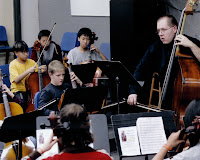 After finishing my doctoral coursework in 2002, I moved out to the suburbs of Chicago, not knowing what I was getting into with building a private studio. Like many bassists, I planned on trying my hand at freelancing (in a bassist saturated city like Chicago). What ensued was the best learning experience of my life, and it gave me many tools and strategies that have made my private teaching endeavors successful over the past 5 years (with as many as 70-75 students a week at one point). This series is meant to give helpful advice, start dialogues among different teachers, and shed light on some of the ‘real world’ aspects of doing what so many of us find we have to do to make ends meet – teach.
After finishing my doctoral coursework in 2002, I moved out to the suburbs of Chicago, not knowing what I was getting into with building a private studio. Like many bassists, I planned on trying my hand at freelancing (in a bassist saturated city like Chicago). What ensued was the best learning experience of my life, and it gave me many tools and strategies that have made my private teaching endeavors successful over the past 5 years (with as many as 70-75 students a week at one point). This series is meant to give helpful advice, start dialogues among different teachers, and shed light on some of the ‘real world’ aspects of doing what so many of us find we have to do to make ends meet – teach.
 In reality, teaching can be one of the most rewarding experiences any double bassist can embark upon – but it can also be the most difficult. You have to be a quick problem solver, often thrown new challenges on a weekly basis: students who don’t practice, scheduling debacles, repetitive pieces. As a teacher, you often find many of your own solutions around these problems, and often innovate to find new solutions to old problems.
In reality, teaching can be one of the most rewarding experiences any double bassist can embark upon – but it can also be the most difficult. You have to be a quick problem solver, often thrown new challenges on a weekly basis: students who don’t practice, scheduling debacles, repetitive pieces. As a teacher, you often find many of your own solutions around these problems, and often innovate to find new solutions to old problems.
I am writing from the perspective of a freelance double bassist who has done a lot of private teaching. With this series, I plan to write about experiences and methods of dealing with all aspects of private teaching that many of us never learned about until we got to the trenches…even the less interesting side of teaching – scheduling and recruiting. These are fundamental to a successful and sustainable studio, especially if you do NOT have a current university or community music school job.
Some topics to be covered include recruiting, networking, resumes, teaching in public schools, home studios, and the like. Keep your eyes on the Bass Blog over the next weeks for installments on this subject.
Bass News Right To Your Inbox!
Subscribe to get our weekly newsletter covering the double bass world.

